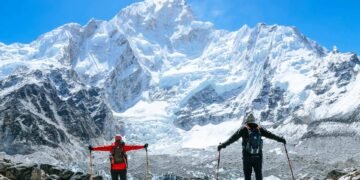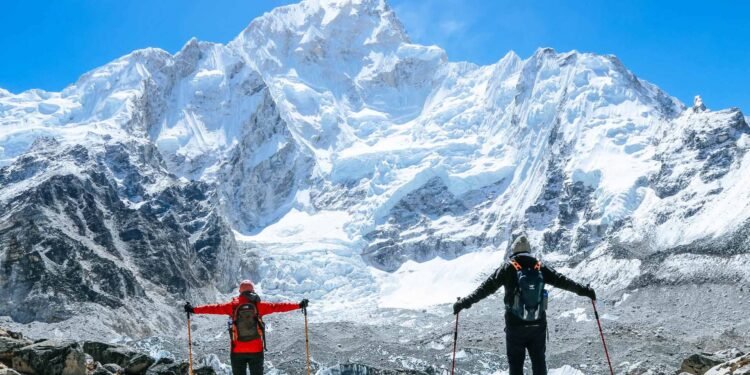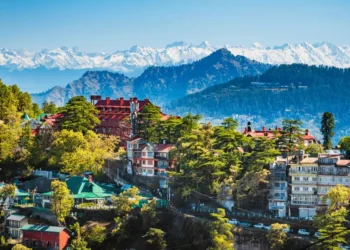Everest Base Camp trekking is one of the most popular treks in Nepal, and it offers breathtaking views of some of the highest peaks in the world. The trek takes you through scenic villages, forests, and high altitude mountain landscapes, all the way to the base camp of Mount Everest.
The trek starts in Lukla, a small town in the Everest region, and from there you’ll trek through a series of small villages, suspension bridges, and steep uphill and downhill sections. You’ll pass through Namche Bazaar, the largest town in the Everest region, and continue to higher altitudes towards the base camp. Along the way, you’ll have the opportunity to see some of the most stunning landscapes and views of the Himalayan range.
The trek can be challenging, with high altitude and varying weather conditions, so it’s important to be physically fit and prepared with proper equipment and gear. It’s also recommended to trek with a guide or a group, for safety and support.
The trek generally takes around 12-14 days to complete, depending on your itinerary and pace. It’s important to acclimatize properly to avoid altitude sickness and to take necessary precautions.
Overall, the Everest Base Camp trekking is a once-in-a-lifetime adventure, and a great way to experience the beauty and majesty of the Himalayan range.

To reach Everest Base Camp, you’ll need to first fly into Kathmandu, the capital city of Nepal. From there, you’ll need to take a domestic flight to Lukla, a small town in the Everest region, which serves as the starting point of the trek. The flight from Kathmandu to Lukla takes about 30-45 minutes, and it’s considered one of the most scenic flights in the world.
Once you arrive in Lukla, you’ll start your trek and follow the trail towards the base camp, passing through small villages, forests, and high altitude landscapes. The trek usually takes about 12-14 days to complete, depending on your itinerary and pace.
It’s important to prepare and pack accordingly, with proper trekking gear, equipment, and supplies. It’s also recommended to trek with a guide or a group for safety and support.
The climate in the Everest Base Camp region varies depending on the season. The best time to trek to Everest Base Camp is during the autumn (September to November) and spring (March to May) seasons, as the weather is generally clear and stable..
During the autumn season, the days are usually sunny and dry with clear skies, while the temperatures are moderate, and the nights are chilly. The daytime temperatures at lower altitudes can range from 10-20°C (50-68°F) and can drop to below freezing at higher altitudes.
During the spring season, the temperatures are similar to autumn, but the days are longer, with more daylight hours. The skies are usually clear in the morning, with clouds forming in the afternoon, and there may be occasional snow or rain showers.
During the winter (December to February), the temperatures can drop significantly, and there is a high chance of snowfall, making the trek challenging and difficult. The summer (June to August) season brings heavy monsoon rains, making the trail slippery and muddy, and reducing visibility.
It’s important to be prepared for varying weather conditions and to pack accordingly for your trek.
Trekking to Everest Base Camp requires good physical fitness and health. The trek involves long hours of walking, steep uphill and downhill sections, and high altitude, which can affect your body. It’s important to be aware of the potential health risks and take necessary precautions to ensure a safe and enjoyable trek.
Some common health risks to consider while trekking to Everest Base Camp include altitude sickness, dehydration, sunburn, hypothermia, and food-borne illnesses. It’s recommended to drink plenty of water, stay hydrated, wear sunscreen and warm clothing, and eat hygienic food to avoid any health issues.
It’s also important to acclimatize properly to the altitude, by taking rest days, walking at a moderate pace, and drinking plenty of fluids. If you experience any symptoms of altitude sickness, such as headache, dizziness, nausea, or shortness of breath, it’s essential to descend to a lower altitude and seek medical attention.
Before embarking on the trek, it’s advisable to consult with a doctor or a travel health specialist to assess your fitness level and any potential health risks. It’s also recommended to obtain proper travel insurance to cover any medical emergencies.
Trekking to Everest Base Camp is an incredible adventure that offers stunning views of the Himalayan range and a chance to experience the unique culture and traditions of the region. However, it requires proper planning, preparation, and awareness of the potential health risks.
It’s important to be physically fit, pack appropriately for the changing weather conditions, and acclimatize properly to the altitude to avoid altitude sickness. It’s also recommended to trek with a guide or a group for safety and support, and to consult with a doctor or travel health specialist before embarking on the trek.
With proper planning and precautions, trekking to Everest Base Camp can be a rewarding and unforgettable experience, and a chance to challenge yourself and push your limits to new heights.

























